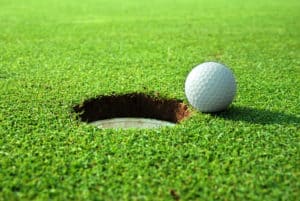
The golf ball is an often-underestimated piece of equipment.
Unlike golf clubs, golf balls may all look similar, but all golf balls are not alike.
Yes, they don’t come in a large variety of shapes and sizes, and always retain their dull, white aesthetic; But that does not mean that all balls are made the same.
They come in varying sizes, weights and covers.
The differences may be marginal on paper, but they make a lot of difference on the golf course.
Let’s take a look at golf ball sizes with some fun and useful facts.
Table Of Contents
Golf Ball Size: Complete Guide

1. What is the average size of a golf ball?

Golf balls come in different sizes.
However, there are specific regulations that rule their size.
An official ball cannot have a diameter shorter than 1.68 inches.
Before the 80s, this figure used to 1.62 inches.
Although both these balls will perform differently, the difference is so nominal that you won’t be able to tell them apart just by holding them.
The manufacture or sale of any ball smaller than 1.68 inches in diameter is illegal in golfing.
This measurement is equal to 42.68mm or 4.268cm.
A ball with this diameter has a circumference of approximately 5.28 inches, which is 134.06mm or 13.41cm.
A golf ball will have a uniform height and width of 43mm on average with the given diameter.
2. Are all golf balls the same size?

The answer to this is both yes and no.
The golfing community has agreed on one standard size for all tournaments.
All balls have to be the specified size for them to be used in professional competitions.
For use in casual games, however, golf balls come in different sizes.
That being said, they will not be smaller than 1.68 inches under any circumstances.
It should also be noted that bigger golf balls were more common before the 80s.
Most manufacturers now stick to an average size of 1.68 inches.
3. When did the golf ball size change?
The size of the official golf ball used in competitions didn’t really change in the US.
The USGA, which is the governing body that oversees golfing tournaments, has always been using golf balls of 1.68 inch diameter.
However, things were a bit different across the pond.
In Europe, the British Open Championship was allowing players to use a golf ball of a smaller size during the 80s.
The British Open is among the oldest and the most revered golfing competitions in the world.
So when the R&A, the British governing body for golf, allowed the use of the 1.62-inch ball, it was not contested.
Although the USGA did not allow the use of other balls, American players participating in the British Open had the option to choose the smaller ball.
Many great players of the time, including Jack Nicklaus and Arnold Palmer, switched to the smaller ball, also known as the British ball.
The two balls remained a bone of contention between golfing communities of both the countries for years.
Neither of the countries would recognize a singular golf ball for international tournaments until 1990.
This was when the global golfing communities finally agreed that the minimum size of the golf ball for all competitions should be 1.68 inches.
4. How wide is a golf ball?
The average golf ball has a width of 1.692 inches, which is 43mm or 4.3cm.
The width of the ball with a 1.68-inch diameter is the minimum acceptable size for the golf ball.
Larger golf balls with a diameter bigger than 1.68 inches can also have a bigger width.
Golf balls with a width of 43mm are the most widely used.
All the major players manufacture balls of this size, as these are the ones commonly used in professional tournaments.
This size was agreed upon after much testing by leading manufacturers.
Balls of this width offer a consistent trajectory, which is ideal for competitions.
Moreover, these balls achieve the optimal spin.
Regardless of the exact width, all golf balls are perfectly circular.
This means that they have a uniform height and width.
5. Golf ball size in cm, mm, and inches.

The size of the golf ball is measured by its diameter, which is the most crucial consideration.
It is also measured by its circumference, its width, and height.
The Diameter
in inch: 1.68
in mm: 42.68
in cm: 4.268
The Circumference
in inch: 5.28
in mm: 134.06
in cm: 13.41
The Width
in inch: 1.69
in mm: 43
in cm: 4.3
The Height
in inch: 1.69
in mm: 43
in cm: 4.3
6. What is the size of golf ball dimples?
Dimples may just look like an aesthetic choice, but they serve a higher purpose.
They are an essential part of the ball’s structure and determine its performance.
The dimples affect the ball’s life and the drag it faces once it has been hit and is in the air.
Generally speaking, there is no limitation placed by any governing body on the size and depth of a golf ball’s dimples.
This is why dimples have changed over the years.
Even today, the size, depth, and number of dimples on a ball will vary from manufacturer to manufacturer.
Despite there being no limitations, most manufacturers stick to 0.01 inches as the average standard depth.
This is not a requirement, and many balls have different depths.
There is also no standard size of how wide the dimples have to be.
7. How much does a golf ball weigh?

Much like the size of the golf ball, its weight is also regulated.
For official tournaments and competitions, a golf ball should be 1.68 inches in diameter with a weight of 46 grams.
For casual games, the ball can be of any size larger than 1.68 inches, as long as it weighs less than 46 grams.
This weight of 45.93 grams to be exact, or 1.62 ounces, is considered to be the ideal weight in the golfing community.
Balls that are heavier or lighter than this lose their efficiency.
You will find balls that don’t weigh exactly the same, which is acceptable.
However, no balls can exceed the maximum set weight.
8. What is a golf ball weight in all measurements.
We understand that our guide is being read by aspiring golfers from all over the world.
Many countries follow different units of measurement for official and general use.
This is why we have listed the weight in different units of measurement for the benefit of our international readers.
in grams: 45.93
in ounces: 1.62
in lbs.: 0.10
in kgs: 0.046
9. How to choose the best golf ball size?

It will be clear even to newer golfers by now that golf balls come in different sizes.
Although the size of the ball used in tournaments is a more popular choice, there is no set limitation on it, as long as it is bigger than 1.68 inches and does not weigh more than 45.93 grams.
Balls also vary in terms of compression and firmness levels.
With so many different varieties, selecting the right ball may be confusing, especially if you don’t have prior experience in golfing.
You don’t always need a ball that meets tournament guidelines; in fact, you hardly ever need it for casual gaming.
To choose the perfect ball for yourself, you first have to determine what experience level you are at.
Are you a beginner who is just getting into the sport?
Or are you an intermediate player with some experience with golfing, even if you don’t consider yourself to be an excellent player?
If you are a new player, don’t be ashamed of selecting an easier ball.
There are plenty of balls in the market, some specially designed for beginners.
These balls are relatively low difficulty.
They help newer players get the hang of the sport without getting too disappointed with not being able to get it right.
Generally, a ball that is designed for beginners will be labeled as such.
Such balls do not travel as much distance as regular balls.
However, the low compression on them enables players to achieve a more precise shot.
These balls are also great for players with a swing speed equal to, or lower than, 85mph.
Another issue that most newer players have is being unable to hit the ball.
Although this can be resolved by using a larger golf club, you can also go for a bigger ball.
There are some great options available in the market from notable golfing brands such as Callaway.
10. What is the best golf ball size for beginner and intermediate golfers?

As a new player, you want a ball that won’t deter you from the sport.
Nothing is worse than losing hope right at the beginning.
You need a ball that gives you confidence.
Regardless of the size, select a ball with low compression as they offer greater control.
Smaller-than-regular balls, like 1.58 inches, are great for females and individuals with good aim.
For seniors, a larger 1.73-inch ball is more comfortable to hit.
If you have been playing golf for some time and consider yourself to be sufficiently proficient, then you shouldn’t be giving yourself an easy time with a ball meant for beginners.
Go for a regular ball, 1.64 inches to 1.68 inches in size, with medium or high compression.
Start with the lower of the two difficulties and work your way up.
11. What is the radius of a golf ball?
This will depend on the size of the particular ball.
Considering the average ball with a diameter of 1.68 inches, the radius will be half of this measurement.
This is 0.83 inches, which is 21.3mm or 2.13cm.
A radius of 0.83 inches is the smallest professional balls will have.
However, it will vary accordingly for casual balls of a smaller or larger size.
12. What is the crater-like design on the golf ball called?
If you have ever seen a golf ball, you probably remember its rather prominent, indented surface.
The entire surface of the golf ball is made up of several small dips lined together.
These are known as dimples.
The dimpled design came into being by chance, before which the golf ball used to be perfectly smooth.
The dimpled design has now become a standard in golf.
It allows the ball to cut through the surrounding atmosphere smoothly and travel faster.
The dimples minimize the effect of drag forces that tend to slow the ball down.
13. Which is bigger, a golf ball or a ping pong ball?

A standard 1.68-inch golf ball is bigger than a ping pong ball, but only by a margin.
Where the golf ball measures at 1.68 inches or 42.68mm, the average ping pong ball today comes in at 1.57 inches, which is approximately 40mm.
This makes it 6.28% smaller than the average golf ball.
This difference used to be close to 11% up until a couple of decades ago.
When the ping pong ball was first invented by J. Jacques, it came at a size of 38mm.
This became the standard for ping pong balls until the size was changed to 40mm in the year 2000.
14. Are British golf balls smaller?
British golf balls may be smaller than 1.68 inches, but so can American golf balls.
Casual golf balls come in at all sizes, both in the UK and the US.
However, there is now an internationally agreed-upon standard (1.68 inches) for tournaments and other competitions.
This regulation is complied with in all tournaments.
Things weren’t always the same, and there was a time when the British and American regulatory bodies did not see eye to eye.
This went on till the 1980s when the British Open Championship allowed the use of smaller balls.
Both countries agreed upon a common standard in 1990.
15. How many dimples are on a golf ball?

Just as the size and depth of the dimples on a golf ball vary, so does their density.
Once again, this is because no regulations define the exact number of dimples that golf balls should be manufactured with.
The number of dimples depends on the size of the individual dimple.
A golf ball of 1.68 inches or bigger can have anywhere between two hundred to five hundred dimples.
This depends on the manufacturer and the type of ball.
You will even find two balls, with a different number of dimples on each one, being sold by the same manufacturer.
Most manufacturers stick to an average of 336 dimples per ball.
This, however, is not because of any set guidelines that they have to follow.
This choice of dimples has to do with the ball’s performance and dynamics when it is in the air.
As a general rule, the higher the density of dimples on a ball, the higher it will lift when it is hit.
Although this sounds like a good thing, too much lift isn’t helpful to any player.
The higher a ball lifts, the lesser distance it will travel.
Seeing as golfers need their ball to travel a decent distance, too many dimples are detrimental to performance.
To strike a balance between the lift and the distance travelled, manufacturers stick to 336 dimples on average.
Of course, this number will vary between balls, even those used in tournaments, but not so much as to deteriorate the ball’s performance.
16. What do the numbers mean on golf balls?
All golf balls come with a number printed on the surface.
Which numbers are printed and how long the series is, depends on the manufacturer of the particular ball.
These numbers are usually single digit, from zero to 9.
However, better customizations now allow golfers to get balls with custom two-digit numbers.
So, what do these numbers mean?
They don’t mean anything, but they do serve a purpose.
These numbers are printed for identification.
Consider a scenario where you and your opponent are both using the same ball from the same manufacturer.
The numbers on the ball help differentiate between the two.
17. What is the liquid inside of a golf ball?
Some golf balls feature a liquid core.
Liquid cores were more common in three-piece golf balls some time ago but are less common today.
This is due to the adoption of more current designs that perform just as well without the liquid.
Balls with liquid cores travel farther than regular balls and also have a bit more swing to them.
Contrary to popular belief, this liquid the balls are filled with isn’t dangerous or toxic.
What it is, exactly, varies from manufacturer to manufacturer.
For instance, Titleist uses a blend of corn syrup and saltwater for their liquid cores.
18. How many golf balls can fit in an Olympic sized pool?

For this calculation, we will make two assumptions.
We are going to assume that the Olympic-sized swimming pool in question only meets the minimum size requirements for an Olympic swimming pool.
These are 25m wide x 50m long x 2m deep.
The second assumption we are going to make is that the golf balls we are filling the swimming pool with are the of the standard size used for tournaments.
This means that we will be considering golf balls with a diameter of 1.68 inches or 42.7mm.
For general feasibility, we will conduct the calculation in mm.
If we were to perfectly stack the balls on top of each other to fill the pool, they would stack the same as cubes.
A cube of the same size will have an approximate volume of 77,854mm.
Dividing the volume of the swimming pool by this value reveals that you can approximately stack 32,111,388 golf balls in an Olympic swimming pool.
19. How many golf balls in a pound?
This is a relatively simple calculation.
Once again, we are going to assume that the golf balls in question are the average standard size used in tournaments.
These balls weigh 45.93 grams, which when converted, comes to 0.10 lbs.
Going by the above measurements, where a standard golf ball measures 0.10 lbs., it is simple enough to calculate that ten such balls will be the equivalent of 1 lb.
Of course, this is the maximum weight of a golf ball, and some balls weigh considerably less, so you could get more balls in a pound if the balls were lighter.
20. What is the circumference of a golf ball?
The circumference of a golf ball of diameter 1.68 inches, which is the officially approved size for professional tournaments, will be 5.28 inches.
This is approximately the same length as 134mm or 13.4 cm.
This circumference will increase as you replace the ball with bigger sized balls, which can be bought for casual golfing.
21. Are European golf balls smaller?
It is important to understand that golf balls are sold in varying sizes all over the world.
Do you get balls smaller than 1.68 inches in the UK and the rest of Europe?
Yes.
But so can you get them in the US.
However, the size of the golf ball for international tournaments and competitions remains the same across countries and continents.
The variations in the size and other features of the golf ball determine its difficulty level.
Smaller sized balls with low compressions are great for beginners and larger balls better suited for the elderly.
Such balls are labelled differently than regular balls and are available regardless of location.
22. How many golf balls can fit across a golf cup?
A golf cup is a hole on the golf course which golfers aim for.
The size of the golf cup, like the size of the balls, is regulated by the USGA in the US and the R&A in the UK.
This size is 4.25 inches.
Golf cups that are larger than this size allow for easy aiming and putting and are not fit for competitive play.
Taking into consideration the size of the official golf cup and the size of the average golf ball, which is 1.68 inches in diameter, the observation is clear.
A golf cup is wide enough for two golf balls to be placed across it, provided you can find a way to balance them both across the hole without them falling inside.
23. How many golf balls can fit in a Boeing 747?
A lot.
It is difficult to get an exact number as an airplane is a much more complicated structure than something as simple as a swimming pool.
There are a lot of variables at play, such as the number of seats, other fixtures, and so on.
Assuming that the 747 in question has been stripped of its seats, it can approximately hold a bit over 23 million perfectly stacked golf balls.



Leave a Reply